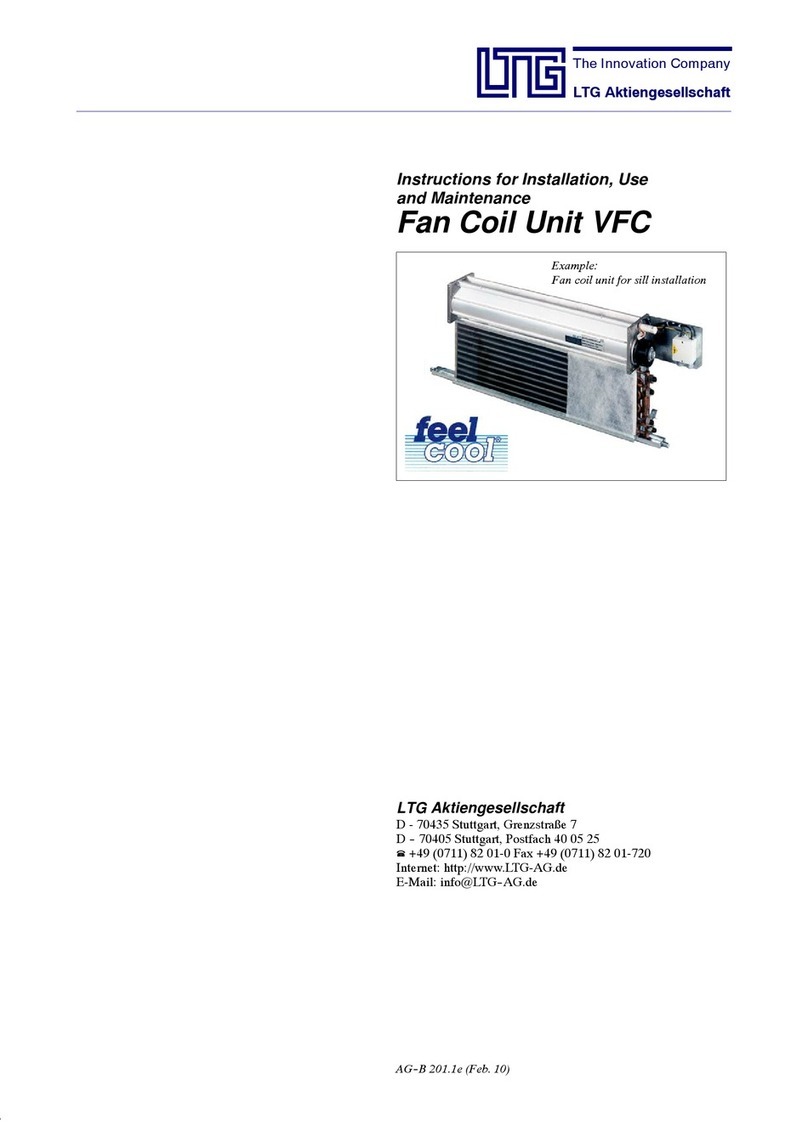
© LTG Aktiengesellschaft Grenzstraße 7 70435 Stuttgart Germany
FVS-eng-BA (08/17)
Tel. +49 711 8201-0 Fax +49 711 8201-720 info@LTG.de www.LTG.net
Former editions are invalid · Subject to technical modifications page 7 of 45
Translation of Original Installation/Use/Maintenance Instructions
Decentralized Ventilation Units FVS Eco2School
3.1 Controller operational mode
Automatic mode
The standard is operation according to CO2 -demand.
If the factory-set CO2threshold is exceeded the ventila
tion will come on automatically.
If the factory-set CO2threshold is undercut, ventilation
stops (threshold may be changed through parameter
setting).
The system works independently without need of any
further operating elements.
Inputs for activation (see chapter 5.4)
AbridgeisplacedattheinputD1toMinthefactory.The
device works without connection of a CO2sensor in per
manent operation in operating mode "Com", conveying
600 m³/h air.
The following four inputs may be used for a central or
decentralized activation on site via button. The factory-
side bridge between the terminals D1 and M then must
be removed.
1. DI 1 Ventilation mode „Com“ (factory-side bridge)
Mode activation with 100 % nominal flow rate (fac
tory-set to 600 m3/h, nominal value parameteriz
able). Ventilation starts if the CO2threshold is ex
ceeded (see CO2-controlled operation). With no CO2
sensor connected the unit will operate continuously
(mode „Com“, independent of CO2value).
The operating modes "Com" and "Eco" are only re-
leased by the device when:
- the exhaust air temperature (room air tempera
ture) is higher than the set parameter "Limit AB" =
+15 °C (factory-side)
-theCO
2concentration in the room exceeds the
threshold (at CO2-controlled ventilation mode, tar
get values CO2“Com” or “Eco” SW-ON = 1000 ppm)
2. DI 2 Ventilation mode „Eco“
Mode activation with 50 % nominal flow rate (fac
tory-set to 400 m3/h, nominal value parameteriz
able). Ventilation starts if the CO2threshold is ex
ceeded (see CO2-controlled operation). With no CO2
sensor connected, a bridge must be placed at the in
put D2 to M. The unit will operate continuously in
„Eco“ mode.
3. DI 5 Forced ventilation
If in the „Eco“ or „Com“ modes „forced ventilation“
has been activated, the CO2level inside the room will
be ignored. Pleasenote: Ventilation will continue un
til “forced ventilation” is deactivated or the mode of
operation changed. The operating modes "Eco" and
"Com" are only released by the unit when theexhaust
air temperature (room air temperature) is higher
than the set parameter "Threshold AB" = +15 °C (fac
tory-side).
4. DI 3 Nocturnal ventilation
In summer, discharge of the heat stored in the room
during the day can be supported by the operating
mode night ventilation. Night ventilation is only re
leased by the unit when the following conditions are
met:
- The exhaust air temperature exceeds the set
threshold (parameter "AB target" = +19 °C factory
side). If the exhaust temperature drops below the
set value, night ventilation is deactivated. Deacti
vation of night ventilation protects the room from
cooling out.
- The temperature difference between supply air
and exhaust air sensor exceeds the set parameter
(parameter "ΔZU/AB=2Kfactory-side)
- The minimum permitted supply air temperature is
reached (parameter "ZUmin" = +5 °C factory-side)
If the operating mode night ventilation is switched
on, the unit will check the existing conditions for ap
prox. 10 min (parameter "Kick duration" = 10 min in
the factory settings). If this inspection is not suc-
cessful, the operating mode night ventilation is
paused for a certain time (parameter "Kick pause" =
80 min in the factory settings). Then the unit will
check the conditions again.
If inspection is successful, the unit continues to run
until one of the above conditions is violated or the
operating mode is changed.
Night ventilation must not be used in winter, in order
to prevent cooling out of the rooms. If night ventila
tion is used in winter anyway, it is possible for the
room to cool down to thelimit of theexhaust temper
ature TAB = 15 °C. If this value is undercut, the device
will switch off and a malfunction message will be is
sued. The duration of the kick phase and kick pause
may need to be adjusted to the situation on site.
For system-related reasons, heating of the outside
air on theway to the room cannot beavoided. Thisef
fect must be considered in design of the night venti
lation and varies according to structure of the venti
lation system.




























